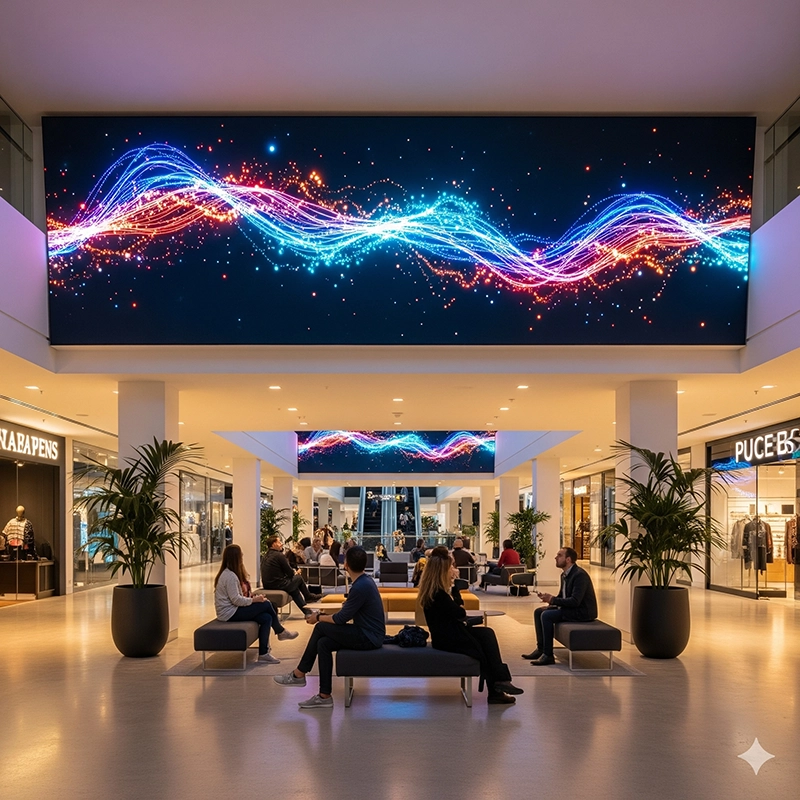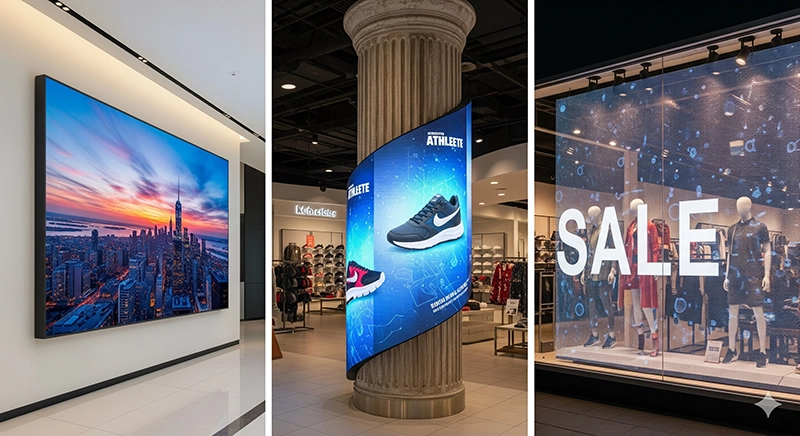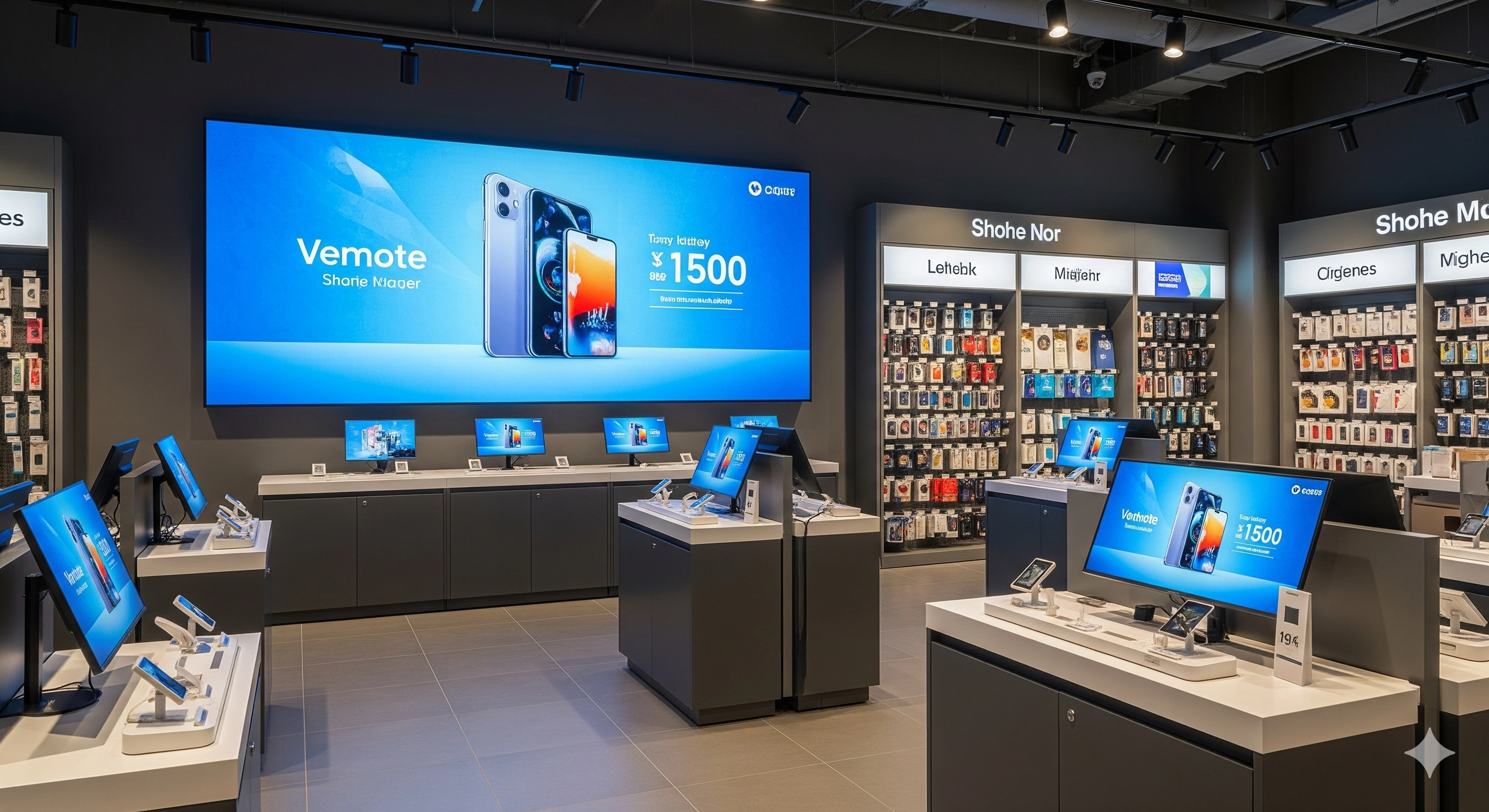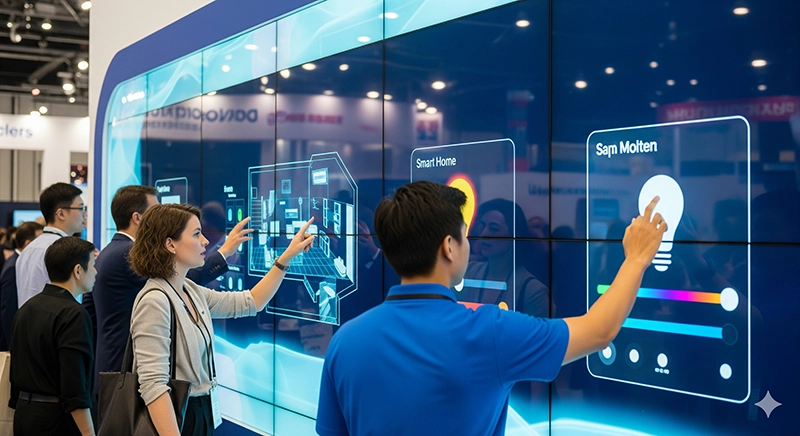LED displays have revolutionized the visual experience in indoor spaces, offering sharp resolution, high brightness, and energy efficiency. By selecting the right LED display, you can enhance your visual content, improve audience engagement, and optimize space usage. This guide explores key strategies for improving the visual experience using indoor LED displays.
Sisäkäyttöön tarkoitetut LED-näytöt ovat tehokkaita visuaalisia ratkaisuja, joita käytetään kaupallisissa, vähittäismyynti- ja julkisissa tiloissa sisällön näyttämiseen eloisalla ja yksityiskohtaisella tavalla. Toisin kuin perinteiset näytöt, LED-näytöt käyttävät valodiodeja korkealaatuisen kuvan tuottamiseen, mikä tarjoaa etuja, kuten paremman kirkkauden, alhaisemman virrankulutuksen ja mahdollisuuden näyttää korkearesoluutioista sisältöä.
Resoluutio: Sisäkäyttöön tarkoitetut LED-näytöt tarjoavat terävän kuvanlaadun ja säädettävän pikselitiheyden parantamaan visuaalista laatua.
Kirkkaus: Sisäympäristöihin räätälöidyt kirkkaustasot varmistavat näkyvyyden myös kirkkaissa olosuhteissa.
Energiatehokkuus: LED-tekniikka kuluttaa vähemmän virtaa, mikä alentaa käyttökustannuksia ja edistää kestävää kehitystä.
Sisäkäyttöön tarkoitettuja LED-näyttöjä on saatavilla erilaisina muotoina erilaisiin tarpeisiin. Oikean tyypin valinta riippuu tilasta ja käyttötarkoituksesta.
Kiinteät LED-näytöt ovat pysyviä asennuksia, jotka sopivat esimerkiksi ostoskeskuksiin, lentokentille ja aulatiloihin. Nämä näytöt tarjoavat selkeän ja kirkkaan kuvan, mikä tekee niistä ihanteellisia digitaalisiin kyltteihin ja mainoksiin.
Joustavat LED-näytöt voivat taipua ja mukautua eri muotoihin, mikä tarjoaa monipuolisia asennusvaihtoehtoja. Ne sopivat täydellisesti kaareviin tai epäsäännöllisiin tiloihin, ja niitä käytetään usein luovissa asetelmissa, kuten lavatapahtumissa ja näyttelyissä.
Läpinäkyvät LED-näytöt päästävät valon läpi, joten ne sopivat näyteikkunaan ja liikkeiden julkisivuihin. Näiden näyttöjen avulla yritykset voivat esitellä sisältöä säilyttäen samalla näkyvyyden näytön läpi.
Sisäkäyttöön tarkoitettua LED-näyttöä valittaessa on tärkeää arvioida tekniset ominaisuudet ja se, miten ne sopivat tavoitteisiisi ja käytettävissä olevaan tilaan.
LED-näytön resoluutio on ratkaisevan tärkeä selkeyden ja kuvan terävyyden kannalta. Keskeinen ominaisuus on pikselitiheys, joka viittaa yksittäisten pikselien väliseen etäisyyteen näytöllä. Pienempi pikselitiheys (esim. 1 mm) johtaa suurempaan resoluutioon ja on parempi lähietäisyydeltä katsomiseen, kun taas suurempi pikselitiheys (esim. 4 mm tai 5 mm) sopii paremmin suurempiin tiloihin, joissa katsojat ovat kauempana.
Kirkkaus on ratkaisevan tärkeää näkyvyyden kannalta, erityisesti tiloissa, joissa on paljon valoa. Ihanteellinen kirkkausalue sisätiloihin on 500–1000 nitiä. Kontrastisuhteet parantavat myös kuvien selkeyttä ja parantavat siten yleistä katselukokemusta.
Oikean koon valinta riippuu käytettävissä olevasta tilasta ja katseluetäisyydestä. Vakiokuvasuhteet, kuten 16:9, ovat suosittuja laajakuvanäytöissä, mutta muutkin kuvasuhteet voivat sopia sisällöstä riippuen.
LED-näytön sijoittelulla on keskeinen rooli sen tehokkuudessa. Oikea sijoittelu varmistaa, että näyttö näkyy yleisölle kaikista kulmista ja vaihtelevissa valaistusolosuhteissa.
Optimaalinen katseluetäisyys riippuu pikselitiheydestä. Pienemmän pikselitiheyden näytöillä katsoja voi olla lähempänä näyttöä vaarantamatta kuvan selkeyttä. Suuremmat pikselitiheydet vaativat katsojan olevan kauempana parhaan käyttökokemuksen saavuttamiseksi.
Seinälle kiinnitettävät näytöt sopivat ihanteellisesti pysyviin asennuksiin, sillä ne integroituvat saumattomasti tilaan. Itsestään seisovat näytöt tarjoavat enemmän joustavuutta ja sopivat tilapäisiin asennuksiin tai tiloihin, joissa liikkuvuus on tärkeää.
Ota huomioon ympäröivä valaistus näyttöä sijoitellessasi. Tiloihin, joissa on paljon valoa, valitse kirkkaampia ja kontrastiltaan suurempia näyttöjä näkyvyyden säilyttämiseksi. Varmista, että näyttö on sijoitettu siten, että auringonvalo ei häiritse sen toimintaa.
Sisätilojen LED-näytölläsi näkyvä sisältö on aivan yhtä tärkeää kuin itse näyttö. Sisällön optimointi näytölle voi parantaa merkittävästi visuaalista vaikutusta ja yleisön sitoutumista.
Varmista, että sisältö on muotoiltu näytön resoluution ja kuvasuhteen mukaan. Korkean resoluution kuvat ja videot ovat ratkaisevan tärkeitä selkeyden ylläpitämiseksi. Käytä myös dynaamista sisältöä pitääksesi yleisön kiinnostuneena.
Interaktiiviset LED-näytöt mahdollistavat kosketuspohjaisen vuorovaikutuksen ja tarjoavat mukaansatempaavamman käyttökokemuksen. Tämä on erityisen hyödyllistä vähittäismyynti- ja näyttelytiloissa, joissa käyttäjän vuorovaikutus voi lisätä sitoutumista ja tarjota arvokasta tietoa.
Jotta sisältösi pysyy tuoreena ja ajan tasalla, tarvitaan luotettava sisällönhallintajärjestelmä (CMS). CMS auttaa aikatauluttamaan, hallitsemaan ja päivittämään sisältöä etänä pitäen näyttösi aina ajan tasalla.
LED-näytön asianmukainen huolto voi pidentää sen käyttöikää ja parantaa suorituskykyä ajan myötä. Säännölliset tarkastukset ja huolto varmistavat optimaalisen toimivuuden.
Näytön puhdistaminen ja pölyn kertymisen tarkistaminen on tärkeää. Käytä LED-näytöille sopivia mikrokuituliinoja ja puhdistusliuoksia näytön vahingoittumisen välttämiseksi.
Varmista, että näyttö on hyvin tuuletettu ylikuumenemisen estämiseksi. Lisäksi ylijännitesuojien käyttö auttaa suojaamaan näyttöä sähköongelmilta.
Teknologian kehittyessä harkitse komponenttien tai ohjelmistojen päivittämistä. Säännölliset korjaukset ja osien vaihdot voivat auttaa ylläpitämään huippusuorituskyvyn koko näytön elinkaaren ajan.
Vaikka LED-näytön alkuinvestointi voi olla suurempi kuin muuntyyppisten näyttöjen, pitkän aikavälin hyödyt tekevät siitä kustannustehokkaan ratkaisun.
LED-näytöillä on yleensä korkeammat alkukustannukset, mutta niiden kestävyys, energiatehokkuus ja vähäinen huoltotarve tekevät niistä pitkällä aikavälillä älykkään investoinnin.
LED-näytöt kuluttavat vähemmän virtaa verrattuna vanhempiin tekniikoihin, kuten LCD- tai plasmanäyttöihin, mikä tarjoaa merkittäviä säästöjä energiakustannuksissa ajan mittaan.
Luotettavan toimittajan valitseminen varmistaa, että saat korkealaatuisen tuotteen, jossa on uusinta teknologiaa ja erinomainen asiakaspalvelu.
Reissopto on LED-näyttöalan johtava tuotemerkki, joka tarjoaa laajan valikoiman korkealaatuisia ja energiatehokkaita sisäkäyttöön tarkoitettuja LED-näyttöjä erilaisiin sovelluksiin.
Myös Samsungin, LG:n ja Leyardin kaltaiset tuotemerkit tarjoavat erinomaisia ratkaisuja sisätilojen LED-näyttöihin ja tarjoavat edistyneitä ominaisuuksia, kuten älykkäitä integraatioita ja korkean resoluution ominaisuuksia.
LED-näyttöteollisuus kehittyy jatkuvasti, ja horisontissa on uusia edistysaskeleita, jotka parantavat näiden näyttöjen ominaisuuksia entisestään.
Uudet teknologiat, kuten microLED ja OLED, lupaavat entistä parempaa suorituskykyä, ja niissä on parannuksia resoluutioon, värien tarkkuuteen ja energiatehokkuuteen.
Älykkäät sisäkäyttöön tarkoitetut LED-näytöt, jotka on integroitu IoT- ja tekoälyteknologioihin, tarjoavat dynaamisempaa ja yksilöllisempää sisältöä, joka mukautuu reaaliajassa yleisön ja ympäristön tarpeisiin.
Kuumia suosituksia
Kuumat tuotteet
Hanki ilmainen tarjous heti!
Ota yhteyttä myyntitiimiimme nyt.
Jos olet kiinnostunut tuotteistamme, ota meihin pikaisesti yhteyttä
Ota yhteyttä myyntitiimiimme tutkiaksesi räätälöityjä ratkaisuja, jotka vastaavat täydellisesti yrityksesi tarpeita, ja vastaa kaikkiin kysymyksiisi.
Sähköpostiosoite:info@reissopto.comTehdasosoite:Building 6, Huike Flat Panel Display Industrial Park, No. 1, Gongye 2nd Road, Shiyan Shilong Community, Bao'an District, Shenzhen City, Kiina
whatsapp:+86177 4857 4559